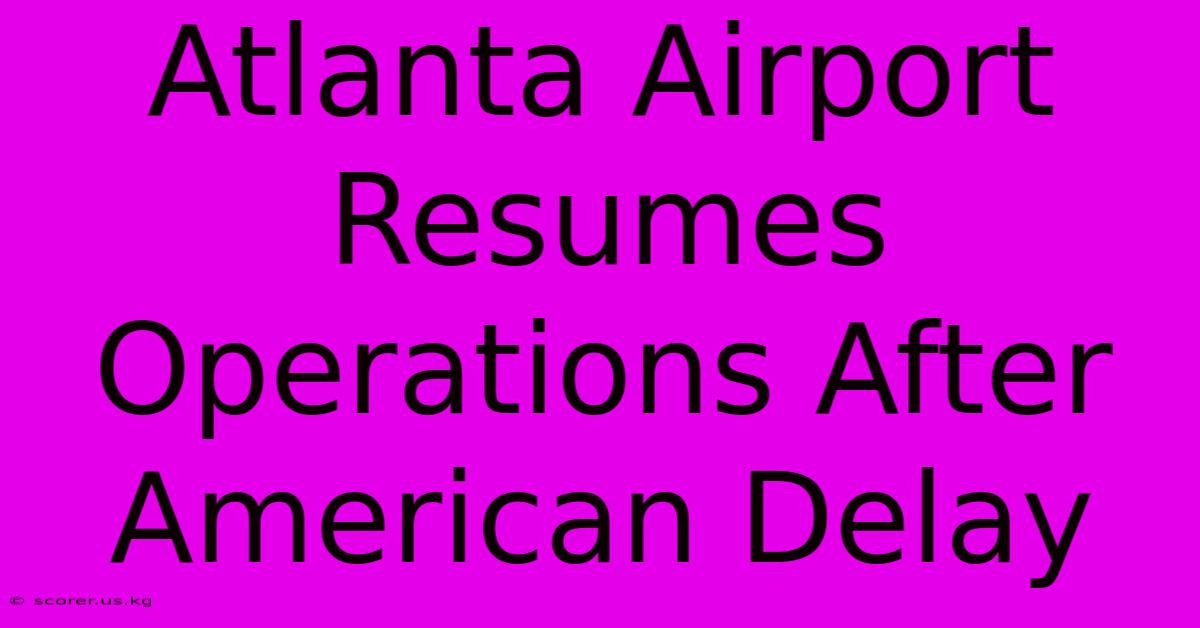Atlanta Airport Resumes Operations After American Delay

Discover more detailed and exciting information on our website. Click the link below to start your adventure: Visit Best Website scorer.us.kg. Don't miss out!
Table of Contents
Atlanta Airport Resumes Operations After American Delay
Hartsfield-Jackson Atlanta International Airport (ATL), the world's busiest airport, has resumed normal operations after a significant delay caused by American Airlines. The disruption, which impacted thousands of passengers, highlighted the vulnerability of even the most robust airport systems to unforeseen circumstances. This article delves into the causes of the delay, its impact, and the airport's response.
What Caused the American Airlines Delay at ATL?
The primary cause of the widespread disruption was a system-wide technology outage experienced by American Airlines. This outage affected flight operations across the country, but the impact was particularly felt at ATL due to its high volume of American Airlines flights. The precise nature of the technology failure hasn't been fully disclosed by American Airlines, but reports suggest it impacted crucial systems involved in:
- Flight scheduling: The outage made it impossible for American Airlines to accurately schedule and track flights, leading to significant delays and cancellations.
- Crew assignments: Difficulties in assigning crews to flights added to the chaos, further compounding the problem.
- Baggage handling: The system failure also reportedly affected baggage handling, resulting in delayed baggage delivery for many passengers.
This confluence of problems created a perfect storm, bringing operations at the world's busiest airport to a near standstill for several hours.
The Ripple Effect: Impact on Passengers and Airport Operations
The American Airlines technology outage had a far-reaching impact:
- Massive flight delays: Hundreds of American Airlines flights were delayed, causing a ripple effect on other airlines and airport operations. Connecting flights were particularly affected, stranding numerous passengers.
- Passenger frustration: Long queues, crowded terminals, and a lack of clear information added to the stress and frustration of thousands of travelers.
- Missed connections: Many passengers missed connecting flights, requiring rebooking and adding to their travel time and inconvenience.
- Hotel accommodations: Some passengers were forced to find alternative accommodation due to missed connections and canceled flights.
ATL's Response and Recovery
Hartsfield-Jackson Atlanta International Airport officials responded swiftly to the crisis. They worked closely with American Airlines and other airlines to:
- Redirect flights: To mitigate congestion, some flights were redirected to other nearby airports.
- Provide information: Airport staff worked to keep passengers informed about the situation and provide assistance.
- Re-route passengers: Efforts were made to re-route passengers onto alternative flights.
- Increase staffing: Airport staff was increased to assist with passenger flow and address the increased workload.
The airport's quick response played a significant role in minimizing the long-term effects of the disruption and in resuming normal operations as quickly as possible.
Lessons Learned: Preventing Future Disruptions
This incident underscores the need for robust contingency plans and redundant systems in the airline industry. American Airlines will undoubtedly be reviewing its technology infrastructure and operational procedures to prevent similar disruptions in the future. This incident also highlights the interconnectedness of the airline industry and the importance of effective communication and coordination between airlines and airports during major disruptions.
Key takeaways include:
- Investing in resilient technology: Airlines need to invest in robust, fault-tolerant technology to minimize the impact of future outages.
- Strengthening contingency plans: Clear and effective contingency plans are essential to mitigate the impact of unforeseen events.
- Improving communication: Clear and timely communication with passengers is crucial during disruptions.
The Atlanta Airport delay serves as a stark reminder of how easily a single point of failure can impact global travel. While the airport has resumed operations, the incident offers valuable lessons for the entire aviation industry about resilience, technology, and effective crisis management.

Thank you for visiting our website wich cover about Atlanta Airport Resumes Operations After American Delay. We hope the information provided has been useful to you. Feel free to contact us if you have any questions or need further assistance. See you next time and dont miss to bookmark.
Featured Posts
-
Mega Millions 1 15 Billion Prize
Dec 25, 2024
-
Hediger Olympic Snowboarder Dies In Avalanche
Dec 25, 2024
-
Avalanche Kills Snowboarder Sophie Hediger 26
Dec 25, 2024
-
Beef And Boards Christmas Show
Dec 25, 2024
-
Mega Millions Jackpot Hit In Lemoore
Dec 25, 2024
